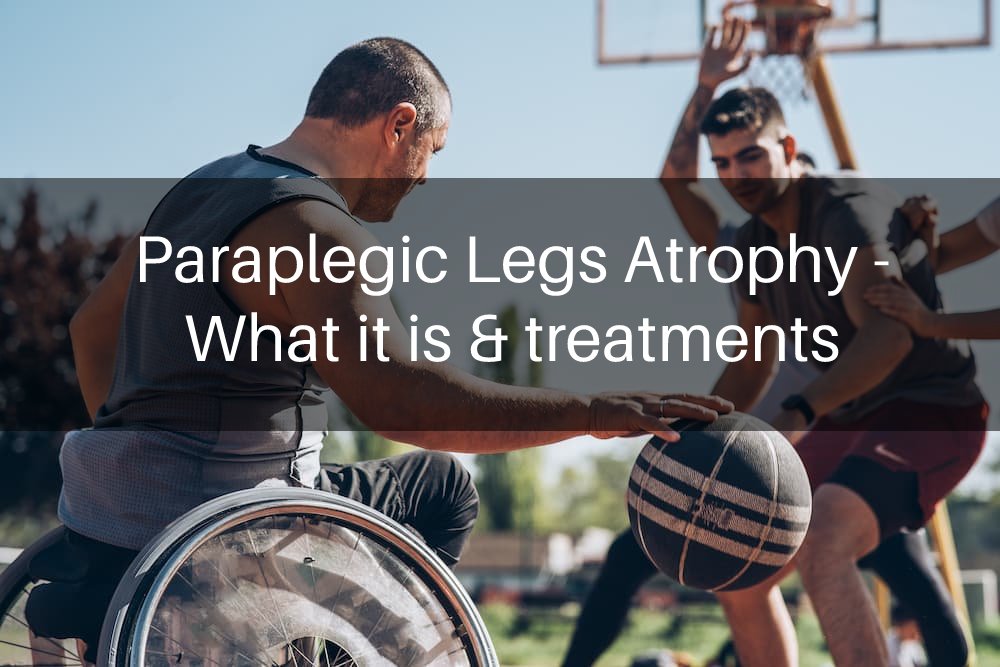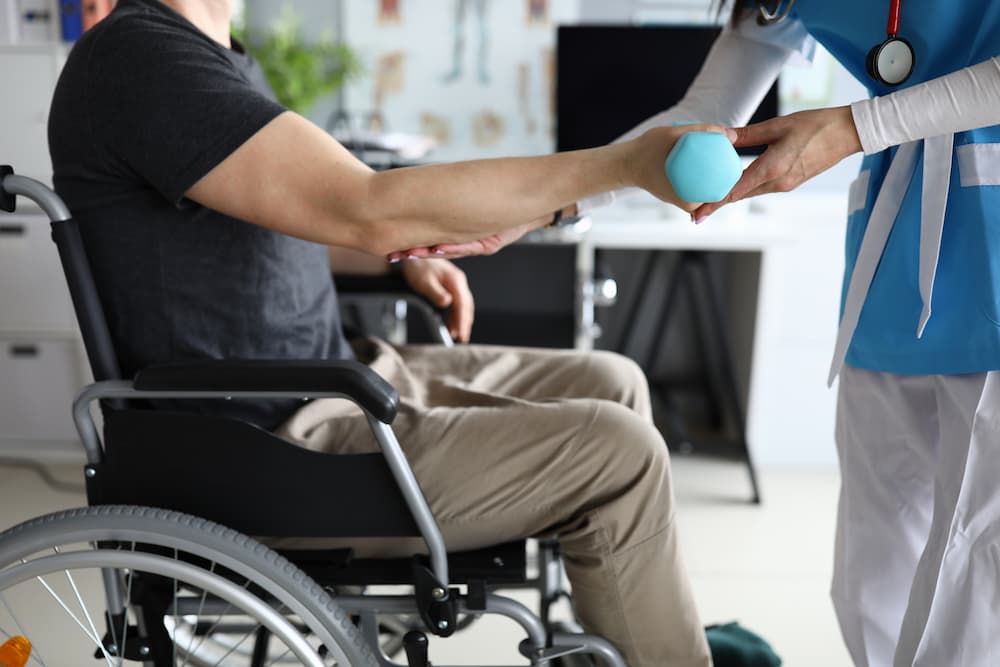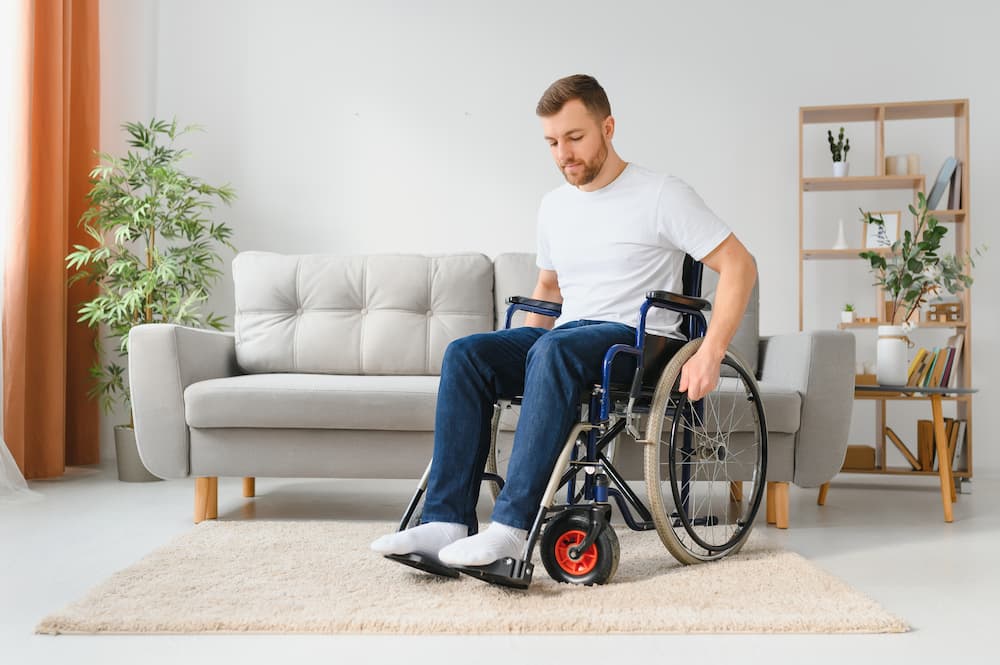Legs atrophy is common among paraplegic individuals. However, this condition is still largely misunderstood.
The main objective of this post is to shed light on paraplegic leg atrophy, discuss causes, and provide other helpful information you need to know about muscle atrophy to improve your (or someone else’s) quality of life.
What is muscle atrophy?
Muscle atrophy refers to the wasting, i.e., loss of muscle tissue in the upper and lower extremities. The loss of muscle tissue occurs due to neurogenic conditions or disuse of muscles.
One or both limbs are noticeably smaller in muscle atrophy, depending on that cause. Patients also experience muscle weakness in the affected limbs.
Various causes can contribute to muscle atrophy, including aging, burns, injuries, alcohol-associated myopathy, malnutrition, stroke, spinal cord or peripheral nerve injuries, and long-term corticosteroid therapy.
The main focus of this post is muscle atrophy in paraplegic legs.
What causes muscle atrophy in paraplegia?
Muscle atrophy in paraplegia results from damage to the nerves that control muscles. As a result, muscles no longer receive signals from the nerve and stop contracting.
The exact cause depends on the type of muscle atrophy. Two main types include denervation atrophy and disuse atrophy.
The term denervation atrophy refers to nerve damage after which muscle contractions stop. This type of skeletal muscle atrophy usually affects patients with a complete or severe type of spinal cord injury since they can’t contract their muscles voluntarily.
Persons with paraplegia typically have this muscle atrophy due to complete spinal cord injury.
On the other hand, disuse atrophy happens when muscles shrink due to a lack of movement. However, this muscle atrophy usually affects people with incomplete spinal cord injuries.
The reality is that various mechanisms play a role in muscle atrophy in paraplegia. For example, a study from Muscle & Nerve found that chronic paraplegia increases skeletal muscle autophagy. Autophagy is the housekeeping process in the body. Autophagy is a conserved cell degradation that removes dysfunctional or unnecessary components.
In this case, autophagic cell death contributes to the impaired balance of the skeletal protein, which contributes to atrophy.
Paraplegia causes downregulation of different pathways and proteins that lead to muscle loss.
Journal of Applied Physiology published a study that evaluated the effects of 10 weeks of paraplegia on routes associated with muscle atrophy.
Results showed a 28% reduction in soleus muscle (muscle at the back of the leg) weight after ten weeks of paraplegia, but there was no change in body muscle mass.
With decreased muscle mass, there was also a change in signaling pathways that participate in translation initiation, protein synthesis, and muscle hypertrophy.
The study shows paraplegia causes atrophy of muscles through changes in signaling pathways that take part in the regulation of protein.
How quickly does paraplegia cause muscle atrophy?
The long-term progression rate of paraplegia is poorly understood.
Muscle mass decreases significantly after the first few months after a spinal cord injury. Then, muscle atrophy gets into a steady state.
A period up to three months after the spinal cord injury is considered an early phase of paraplegia.
After that, a 50% stable atrophy occurs up to two years after incomplete SCI, i.e., spinal cord injury. In one study, the thickness of muscle bulk dropped by 40% within the first month.
Muscle atrophy is progressive, meaning it involves long-term adaptation. While there is no specific timeframe during which people with paraplegia lose muscle mass, the first few months affect the most significant progression of atrophy. Later, atrophy becomes stable. Stable doesn’t mean it stops, though.
Can leg muscle atrophy be reversed?
Disuse atrophy tends to be reversible through regular exercise and a well-balanced diet.
Regaining muscle mass doesn’t occur instantly. Results come gradually. However, paraplegia is generally incurable. As seen above, muscle atrophy here happens due to nerve damage.
This kind of muscle atrophy is generally irreversible. Patients with paraplegia involving complete lesions can slow down muscle atrophy and improve blood circulation.
How do you prevent muscle atrophy after spinal cord injury?
Persons with spinal cord injury can prevent muscle atrophy, or slow it down, with a proactive approach that involves adhering to the doctor’s recommendations.
Exercise regularly
Exercise is the most effective way to prevent or reduce muscle atrophy following spinal cord injury. The role of exercise is to slow down muscle atrophy and improve blood circulation and metabolism.
Evidence shows stimulation of paralyzed limbs positively correlates to metabolic changes such as insulin resistance. In other words, exercise is beneficial for the cardiovascular system.
People with paraplegia have two options for exercise. The first option is to perform the voluntary exercise with non-paralyzed muscles. However, they can also participate in passive range of motion exercises. Arm exercises are a good example.
Passive range of motion exercises is where patients don’t make any movement on their own. Instead, a physical therapist gently moves the paralyzed limbs to stretch the muscles.
A physical therapist is the one who creates an exercise plan. The therapist customizes the exercise plan to match the patient’s condition and needs. They may also teach patients and their caregivers to perform simple yet beneficial exercises at home.
Patients with paraplegia can use their arms and leg lifters to move their legs. Some exercises that could help include:
- Side leg lifts
- Ankle rotations
- Knees to chest exercise
- Hamstring stretch
- Ankle pull
- Seated elliptical
- Knee extensions
- Seated marches
People with paralyzed legs can perform some exercises in their wheelchairs. Other activities require lying on the ground, which is why it’s helpful to have assistance if performing them at home.
It is essential to perform repetitive and task-specific exercises.
Although it may seem complicated, exercise is vital for persons with paraplegia and the best approach to tackle muscle atrophy.
Functional electrical stimulation
Functional electrical stimulation FES relies on electrical current to produce muscle contraction in paralyzed persons. As a subtype of neuromuscular electrical stimulation (NMES), FES can significantly improve the quality of life in persons with complete spinal cord injury.
At the same time, electrical stimulation can improve walking performance in patients with incomplete injury.
Studies show that functional electrical stimulation increases muscle fiber area and capillary number in people with complete spinal cord injuries. As a non-invasive treatment option, FES involves placing electrodes on the skin over the specific muscles. The treatment could strengthen the muscles and thereby slow down atrophy.
One example of FES is electrically induced cycle training in patients with severe spinal cord injury. In one study, participants who tried this training performed better than control subjects.
The training was beneficial for muscle fibers even 20 years after the injury.
Healthy diet
A well-balanced diet is the cornerstone of a healthy lifestyle.
Unhealthy foods cause weight gain and increase the risk of health problems. They’re also more likely to increase fat mass and reduce muscle mass.
Therefore, eating a healthy diet is vital to prevent or slow down muscle atrophy.
According to a Journal of Spinal Cord Medicine study, women with paraplegia tend to have a lower calorie intake with macronutrient consumption at recommended levels. They were able to maintain a healthier diet, reduce fat intake, and have lower rates of overweight or obesity.
On the other hand, men with paraplegia tend to have higher than recommended fat intake. The same study showed that around 74% of participants were overweight or obese.
Muscle atrophy and increase in fat mass tend to result from neurologic impairment. That happens because spinal cord injury alters sympathetic innervations, muscle tone, thyroid hormone levels, and muscle fiber. In people with paraplegia, metabolism is slow due to low energy expenditure.
Since metabolism is slow and persons with paraplegia are at an increased risk of gaining weight, a healthy diet is crucial. There is no specific dietary pattern to which persons with paraplegia should adhere.
Healthcare professionals may recommend some dietary changes. If you’re unsure what to do, you can consult a dietitian or nutritionist to create a customized meal plan.
Generally speaking, your diet should consist of healthy fats, carbohydrates, and protein. The latter is crucial for building and maintaining muscle mass. That’s why it could help persons with paraplegia slow down atrophy.
You may want to eat high-protein foods, including fish, chicken, lean meats, yogurt, nuts, and tofu.
While carbohydrates may sound alarming, you do need them for energy. Just eat them in moderation and opt for complex rather than simple carbohydrates. Strive to eat fruits, vegetables, and whole grains.
As far as healthy fats are concerned, Omega-3 fatty acids and olive oil are beneficial for combating inflammation and supporting cardiovascular health.
Get a massage
Massage is a great way to relieve stress, promote muscle recovery, and improve blood circulation simultaneously.
Persons with paraplegia who can’t move their muscles can also benefit from a massage because it can improve their overall health and help release tension from weight-bearing joints and muscles.
People with spinal cord injury have problems with poor blood flow, which is also the case for paraplegic patients who spend much time in a wheelchair.
That’s where a massage can be an option. Massage increases blood flow to the massaged muscles and surrounding muscle area.
For the best effects, you may want to get a massage regularly, e.g., once a week. Find a certified and reputable massage therapist with experience in helping persons with paraplegia.
FAQ
Why do paralyzed legs shrink?
Paralyzed legs shrink due to muscle atrophy caused by a lack of muscle contraction and leg movement.
Proper blood flow is necessary for supplying tissues and muscles with nutrients. Impaired blood circulation prevents the delivery of nutrients and could contribute to the loss of muscle size.
One older study found that healthy blood flow in the paralyzed anterior tibial muscle (a muscle that runs down the front of the shin) in persons with paraplegia was significantly lower than in their biceps.
A published study from the Journal of Applied Physiology showed blood flow was better in the upper than lower limbs of paralyzed subjects. That said, training could reverse the increased vascular resistance in paralyzed limbs.
What is chronic spinal cord injury?
Chronic spinal cord injury refers to a permanent or progressive interruption in the conduction of impulses across the spinal cord’s tracts and neurons. In this case, people are spinal cord injury due to tumor, trauma, infection, or other space-occupying traumatic cord lesion types.
Doctors use the term chronic SCI when the elements of the injury to the spinal cord have been present for at least one year. Patients affected usually need CT scans, MRIs, or other imaging tests.
Can you achieve muscle growth in paraplegia?
The loss of muscle function is one of the most significant characteristics of paraplegia. For that reason, even with muscle activation through exercise, it would still be complicated or nearly impossible to achieve muscle growth.
However, SCI patients should strive to work with their physical therapist or stick to physical activity plan and training program to prevent dramatic changes in body composition, such as excess body weight. In other words, exercise can help skeletal muscles avoid losing their mass quickly.
What is a motor neuron, and what happens when it’s damaged?
A motor neuron is a type of neuron located in the spinal cord and the brain. Damage to the motor neurons causes muscle spasticity or stiffness and overactive reflexes. A patient loses the ability to control movements or walk.
Eventually, muscle performance significantly worsens, and muscle fiber size decreases in paralyzed patients.
Do you lose bone mass due to paraplegia?
Spinal cord injury SCI affects bone health as well. Complete SCI leads to extreme and prolonged immobilization that changes the loading pattern of lower limbs and alters skeletal structure. That’s why people with spinal cord injuries are at a higher risk of losing bone density.
Bone loss in spinal cord injured individuals increases the likelihood of fractures. Additionally, bone loss may continue for about two years, after which it stabilizes. Even then, bone formation is nonexistent, and a patient is susceptible to osteoporotic fractures.
How to prevent pressure sores?
Lack of movement in paralyzed extremities reduces circulation. In turn, nutrient-rich blood doesn’t reach all areas properly. Skin cells start dying, and pressure sores occur.
Persons with paraplegia can prevent pressure sores by choosing a high-quality wheelchair. It also helps to get a wheelchair cushion that provides support and comfort and evenly distributes weight. Your pillow should also support blood flow rather than restrict it.
For many people, memory foam and gel cushions work best.
Conclusion
Paraplegic legs are prone to muscle atrophy due to the lack of movement and muscle contractions. In paralyzed persons, nerve damage doesn’t allow muscles to receive signals that trigger movement.
While muscle atrophy is a severe problem, regular exercise, a healthy diet, and functional electrical stimulation could slow it down. Most importantly, persons with paraplegia and their caregivers need to maintain a proactive approach that motivates them to work on improving their health and quality of life.
References
https://my.clevelandclinic.org/health/diseases/22310-muscle-atrophy
https://www.flintrehab.com/muscle-atrophy-due-to-spinal-cord-injury/
https://www.medicalnewstoday.com/articles/325316
https://www.ncbi.nlm.nih.gov/pmc/articles/PMC3471789/
https://www.nature.com/articles/3102131
https://www.ncbi.nlm.nih.gov/pmc/articles/PMC1756242/pdf/v034p00322.pdf
https://www.ncbi.nlm.nih.gov/pmc/articles/PMC4519233/
https://www.ncbi.nlm.nih.gov/pmc/articles/PMC1949032/
https://pubmed.ncbi.nlm.nih.gov/9025213/
https://www.ncbi.nlm.nih.gov/pmc/articles/PMC8645754/
https://www.ncbi.nlm.nih.gov/pmc/articles/PMC2647496/
https://www.nature.com/articles/sc197230.pdf?origin=ppub




